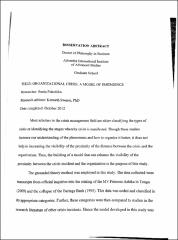Organizational crisis : a model of emergence
Abstract
Most scholars in the crisis management field are either classifying the types of
crisis or identifying the stages whereby crisis is manifested. Though these studies
increase our understanding of the phenomena and how to organize it better, it does not
help in increasing the visibility of the proximity of the distance between the crisis and the
organization. Thus, the building of a model that can enhance the visibility of the
proximity between the crisis incident and the organization is the purpose of this study.
The grounded theory method was employed in this study. The data collected were
transcripts from official inquiries into the sinking of the MV Princess Ashika in Tonga
(2009) and the collapse of the Barings Bank (1995). This data was coded and classified in
its appropriate categories. Further, these categories were then compared to studies in the
research literature of other crisis incidents. Hence the model developed in this study was
grounded in data from the inquiry reports as well as the literature review data and can be
applied to cumulative crisis.
There were 4 major categories found in this study that are organizational
antecedents, push factors, pull factors, and vulnerability factors. The presence of these 4
categories was found to increase (if it has high presence) or decrease (if it has low
presence) the crisis potential of the organization; hence, a proximity matrix was
developed. Elements of the proximity matrix were used together with chaos theory and
nonnal accident theory to depict the emergence of a crisis. Based on the proximity matrix
and its depiction, recommendations for organizations as well as for future research were
also suggested.


